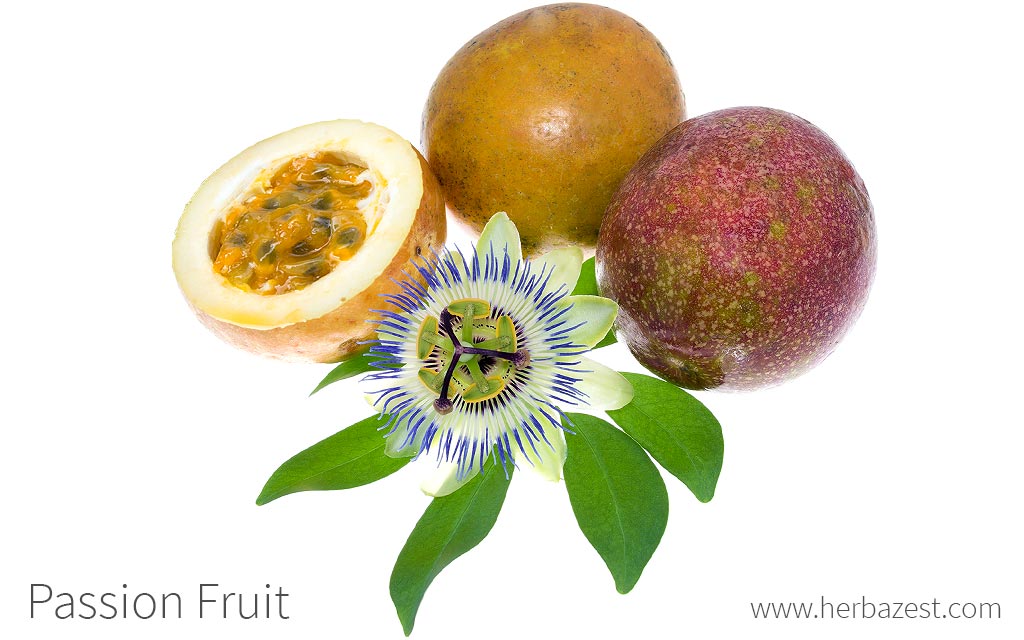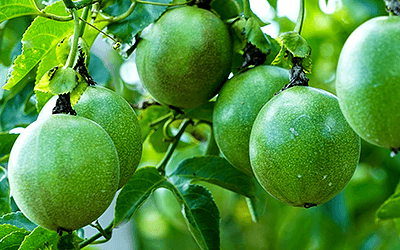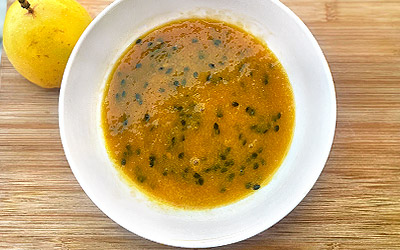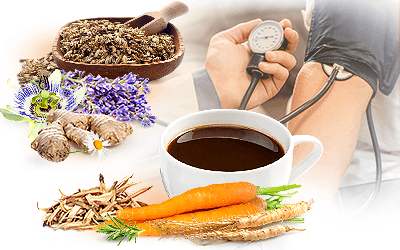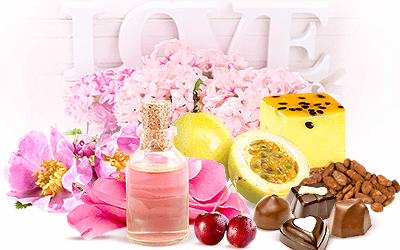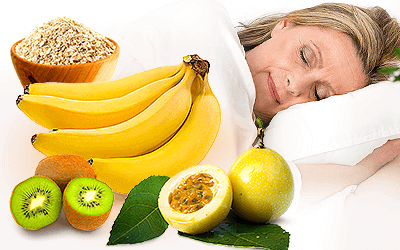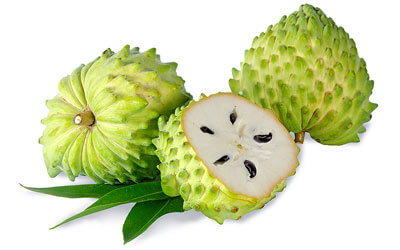Passion fruit – originally from South America – is not just a culinary and aromatic delight, but it also contains medicinal compounds. This tropical fruit is now cultivated across the globe for its many benefits.
Passion Fruit Medicinal Properties
- Medicinal action Anxiolytic, Hypotensive
- Key constituents Flavonoids, beta-carboline alkaloids, phenolic compounds
- Ways to use Capsules, Hot infusions/tisanes, Food, Juiced, Powder
- Medicinal rating (3) Reasonably useful plant
- Safety ranking Safe
Health Benefits of Passion Fruit
Passion fruit's medicinal properties have been traditionally used to treat a wide range of health conditions. Nowadays, it is mainly consumed for:
Relieving stress and anxiety. Among the most important passion fruit's benefits is its relaxant effect, which helps soothe the nerves, reducing anxiety and controlling panic attacks.
Lowering blood pressure. In part due to its anxiolytic properties, passion fruit also provides hypotensive effects, which help maintain cardiovascular health.
Additionally, passion fruit can be helpful for improving digestion and bowel movements as well as for supporting bones health.
How It Works
The aerial parts of passion fruit have shown relaxant effects in low doses and sedative actions in higher doses. This is mainly due to the abundance of flavonoids; however, it is thought that other compounds may also be responsible for these nerve-soothing benefits.1,2 A group of beta-carboline alkaloids (harman, harmin, harmalin, harmol, and harmalol) have shown some influence over the central nervous system, and some studies suggest they may contribute to the calming and hypotensive effects of passion fruit.3,4
The combined action of the phenolic compounds, ascorbic acid, alkaloids, carotenoids, and flavonoids contained in the pulp of yellow passion fruit have proven effective in reducing systolic blood pressure.
YELLOW PASSION FRUIT CONTAINS APPROXIMATELY 165 VOLATILE COMPOUNDS.
Other herbs that promote relaxation and reduce anxiety are jasmine, lemon balm, and valerian, whereas lucuma and saffron help reduce blood pressure and support cardiovascular health.
Side Effects of Passion Fruit
When consumed in excess, passion fruit can also cause somnolence, and the latex present in the rind and other parts of the plant may trigger allergic reactions, including itching, rash, watery eyes and nose, and asthma.
Cautions
The pulp of passion fruit contains cyanogenic glycosides, which are natural plant toxins present in several species. Unripe passion fruits contain the highest concentration of cyanide glycosides, losing most of their toxicity as they mature. When ingested, cyanogenic glycosides interact with digestive enzymes, releasing hydrogen cyanide, which is poisonous in significant amounts.
Early symptoms of cyanide poisoning include lightheadedness, giddiness, rapid breathing, nausea, vomiting, feeling of neck constriction and suffocation, confusion, restlessness, and anxiety.
When buying passion fruits, it is safer to pick the mature, wrinkled ones, which also release a strong, citrus odor and have a sweeter flavor.
People taking antihypertensive drugs, as well as those consuming sedatives and anxiolitics, must be aware that consuming passion fruit in excess or in remedial forms can potentiate the effects of those medications.
Additionally, people taking medications to prevent transplant rejection, such as tacrolimus or cyclosporine, are advised not to consume passion fruit.
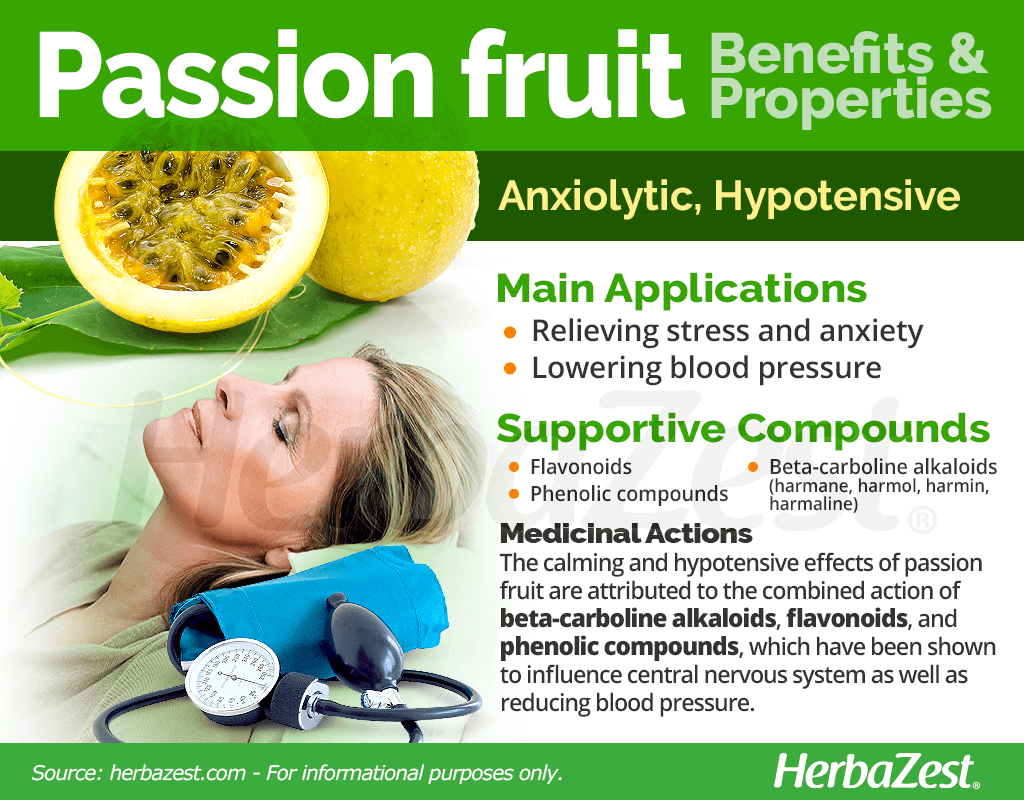
Passion Fruit Nutrition
Passion fruit is popular for its citrusy, sweet flavor, but it is also a good source of essential nutrients. Passion fruit juice provides generous amounts of vitamin C (ascorbic acid), which is necessary for boosting immunity, also aiding iron absorption for red blood production and healthy bones.
Additionally, passion fruit contains B group vitamins, mainly B3 (niacin), along with B2 (riboflavin), and small amounts of B6 (pyridoxine). B vitamins are essential for metabolic functions, such as proper protein and fat absorption, energy levels and eye health, as well as optimal nerve and brain function.
Moreover, this delicious, exotic fruit provides good amounts of potassium, which is crucial for blood pressure and electrolytes balance, making the passion fruit juice a great option after a sweaty workout session.
The nutritional value of passion fruit is rounded by adequate amounts of copper and pro-vitamin A.
100 grams of concentrated passion fruit juice provide 60 calories, 5% of the recommended daily value for carbohydrates and 28% DV of sugar.
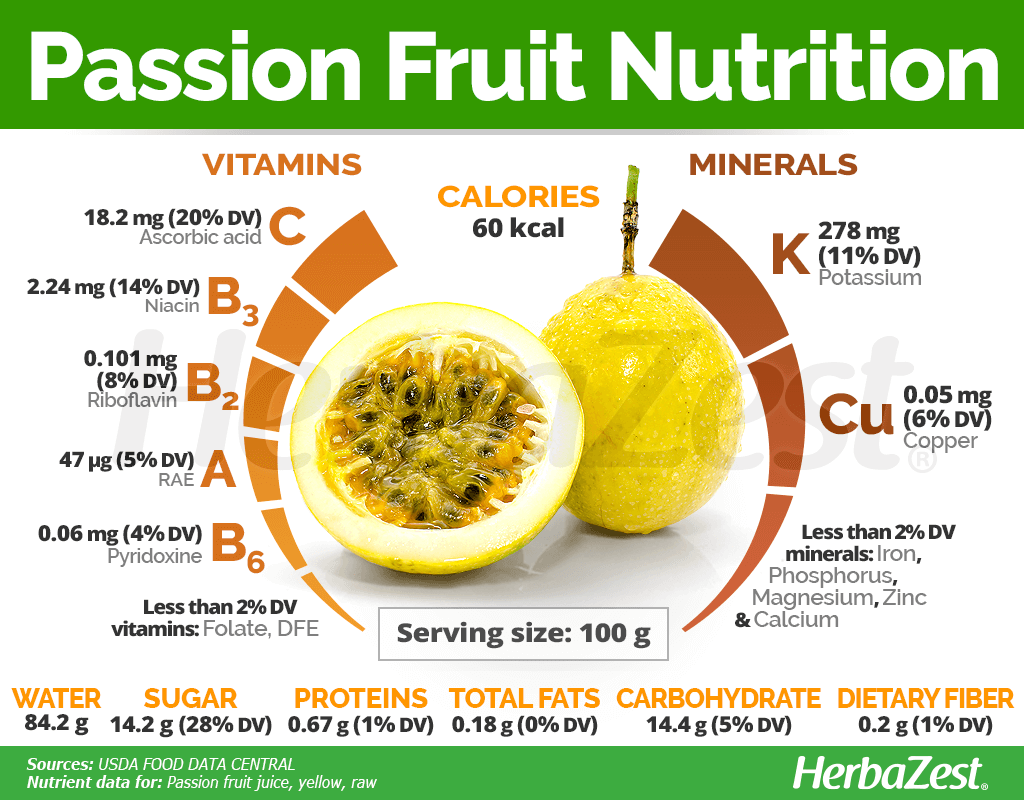
How to Consume Passion Fruit
- Edible parts Fruit
- Edible uses Flavoring, Beverage
- Taste Sweet
Passion fruit is typically consumed as a culinary delight. However, in order to maximize its health benefits, this exotic fruit can also consumed in medicinal preparations.
Natural Forms
Raw. To consume passion fruit raw, the rind is sliced and opened, revealing the seeds and pulp. The pulp is then scooped out and swallowed without chewing the seeds. The pulp of purple varieties of passion fruit is less acidic and about 35% juicier than yellow passion fruit.
Juice. Passion fruit juice is a refreshing and mess-free way to enjoy the fruit and reap its relaxant and hypotensive benefits.
Infusion. Enjoyed for both its taste and relaxation properties, passion fruit infusions are typically brewed from teabags or loose-leaf preparations.
Powder. The benefits of the whole dried and processed fruit can also be reaped in powder form.
Herbal Remedies & Supplements
Essential oil. Obtained from the seeds, passion fruit essential oil is commonly used in aromatherapy for its calming effects, but it is also popular for massage therapy and nerve soothing baths.
Capsules. A concentrated form of passion fruit, capsules are useful for treating anxiety disorders and lowering blood pressure.
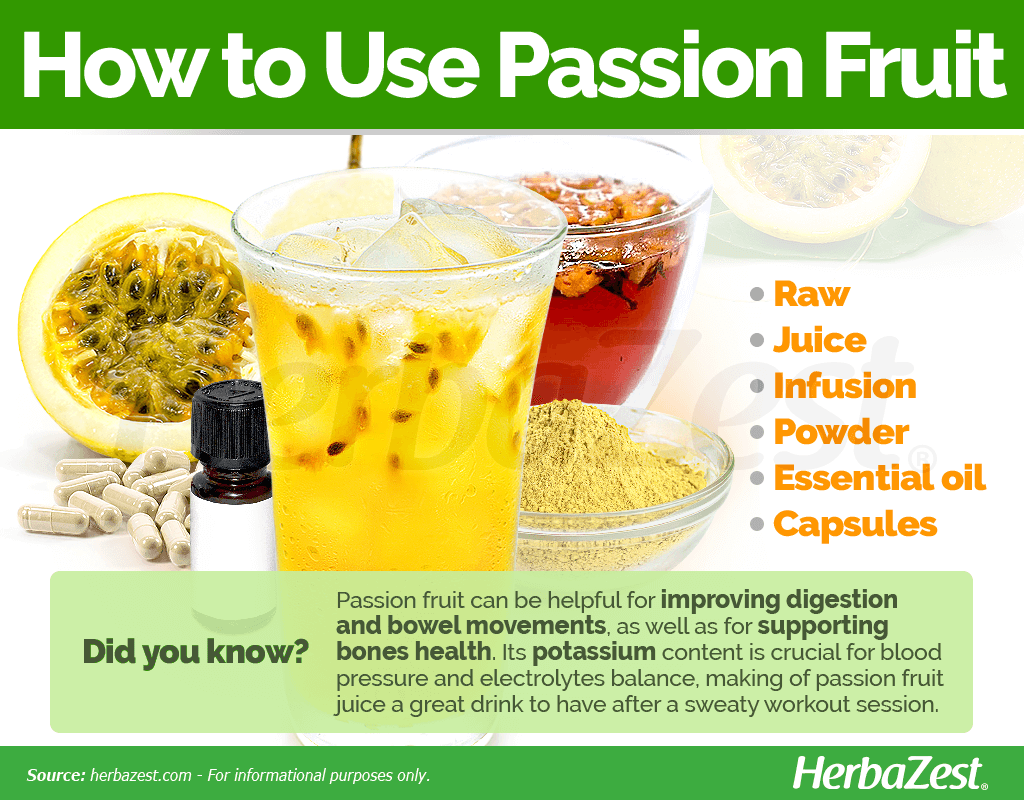
Growing
- Life cycle Perennial
- Harvested parts Fruit
- Light requirements Full sun
- Soil Loamy sand
- Soil pH 6.1 – 6.5 (Slightly acidic), 6.6 – 7.3 (Neutral), 7.4 – 7.8 (Slightly alkaline)
- Growing habitat Subtropical regions
- USDA Plant Hardiness Zones 6a, 6b, 7a, 7b, 8a, 8b, 9a, 9b, 10a, 10b
- Pre-germination seed treatment Soaking
- Plant spacing average 3 m (9.84 ft)
- Propagation techniques Cuttings
- Potential insect pests Aphids
- Potential diseases Cucumber mosaic virus
Passion fruit is a tropical vine and requires a habitat similar to its native one to thrive. In warm areas, it can be successfully grown at home.
Growing Guidelines
Passion fruit vines are usually grown from seeds, but they can also be propagated from cuttings, which require hormone treatment and 90 days of rooting before being transplanted.
Passion fruit plants can thrive in most types of soils as long as they are well-drained, with a pH range of 6.5-7.5. If the soil is too acid, lime must be applied.
Passion fruit plants full sun exposure. However, when temperatures are too high, partial shade is also required.
For commercial purposes, the vines are trained to strongly-supported wire trellises at least seven feet (2.13 m) high. However, for home gardeners it is much easier letting the plant to climb a tall tree, which will also make it less prone to pests and diseases.
Regular watering will keep a vine flowering and fruiting almost continuously, and it is especially important when fruits are approaching maturity. Both water and nitrogen fertilization balance is key to developing high quality, flavorful fruits.
The passion fruit vine, especially the yellow variety, is fast-growing and will begin to bear fruits within one to three years.
In tropical areas, like Hawaii, passion fruits mature from June through January, with heaviest crops from July to August, as well as in October and November.
Additional Information
- Other uses Animal feed, Cosmetics
Plant Biology
Passion fruit is a large vine with green leaves, 3 - 8 inches (8 - 20 cm) long, and fragrant white and purple flowers. It is prized for its fruit, which is round and covered in a waxy hard shell and a sweet, orange-yellow pulp.
Classification
Passion fruit is a member of the Passifloraceae family, which contains 530 species spread across 27 genera. Members of this family includes trees, shrubs, and climbing plants, all of which flower. Most species of the Passifloraceae family grow in tropical regions.
Varieties and Cultivars of Passion Fruit
There are two naturally-occurring varieties of passion fruit (Passiflora edulis), yellow and purple. Prominent yellow cultivars include 'Yee Selection,' 'Noel's Special,' 'Hawaiiana,' and 'Mirim,' among others. Some of the most widely-cultivated purple cultivars are 'Bali Hai,' 'Ouropretano,' 'Common Purple,' and 'Brasilera rosada.'
Historical Information
Although passion fruit has most likely been grown for much longer, the earliest recordings of it are from the 16th century, when it was made known to the Western world via Spanish conquerors in Brazil. From there, it was taken to Europe before spreading throughout the rest of the globe. In 1880, it was introduced to Hawaii, where it adapted easily and eventually began growing wild.
Economic Data
Brazil currently produces the highest amounts of passion fruits in the world. However, they are grown in most places across the tropical belt, including other South American countries, Australia, and parts of Asia and Africa.
It is estimated that the total worldwide production of passion fruit each year is 852,000 tons. Brazil accounts for 90% of production, and the principle market is Europe, which imports more than 90% of the juice produced.
Other Uses
Fodder. The fruit's rind can be chopped for use as cattle fodder or be converted into silage.
Cosmetics. Passion fruit essential oil is also sometimes used in perfumes, soaps, shampoos, and other personal care products.
Sources
- Centers for Disease Control and Prevention, HYDROGEN CYANIDE (AC): Systemic Agent
- Fruits of Warm Climates, pp. 320–328
- National Health Service, Passion fruit peel 'relief' for asthmatics, 2008
- University of Idaho, Cyanogenic glycosides
- University of Michigan, Latex Allergy | Medicines
- USDA Nutrient Database, Basic report 09233: Passion-fruit juice, yellow, raw
- Journal of Medicinal Food, Passionflower fruit - a "new" source of lycopene?, 2005
- Germplasm Resources Information, Passiflora edulis Sims
- Journal of Agricultural and Food Chemistry, Cyanogenesis of Passiflora edulis, 1983
Footnotes:
- Journal of Ethnopharmacology. (2010). Anxiolytic and sedative activities of Passiflora edulis f. flavicarpa. Retrieved December 16, 2021, from: https://pubmed.ncbi.nlm.nih.gov/20051259/
- Phytotherapy Research. (2013). Assessment of Sedative Effects of Passiflora edulis f. flavicarpa and Passiflora alata Extracts in Mice, Measured by Telemetry. Retrieved December 16, 2021, from: https://pubmed.ncbi.nlm.nih.gov/23893399/
- Neuroscience.(2002). GABA mechanisms and sleep. Retrieved December 16, 2021, from: https://pubmed.ncbi.nlm.nih.gov/11983310/
- Biulleten' eksperimental' noi biologii Meditsini. (1982). Characteristics of GABA-potentiating effect of harman. Retrieved December 14, 2021, from: https://pubmed.ncbi.nlm.nih.gov/6293612/

